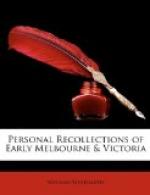Our inspection was completed by a view of the kitchen and larder, and the interesting spectacle of about 300 of the men engaged together under one roof at dinner, every one of whom revelled in solid beef to his heart’s content. Included in their number were twelve Chinamen, who seemed as comfortably at home as any of the others, and whose presence, perhaps, helped to impress a Chinese Commissioner, who had lately visited the Asylum, and who had left his record in the visitors’ book to the effect that such an institution was an honour to mankind.
The old Melbourne cemetery.
The old Flagstaff Hill and the old cemetery were two objects which I sought for on the earliest opportunity, and as the business day-time was so full of work, I took the early morning. The Flagstaff Hill I had soon to give up as quite unrecognizable under new plantations and roadways, but the cemetery, in its close vicinity, was much as I had left it, and there the old friends, albeit voiceless now, cropped up at every turn. Let me select a few, commenting as I go along, and beginning with the earliest in date.
1841.
A series of the well-known early family of the Langhornes, some of whose members I often met. Let me begin with “The wife of William Langhorne,” who died in this far back year, and end with Alfred, who used to amuse us all with interminable stories, who had a strikingly beautiful wife, and who died in 1874.
1846.
“The beloved wife of Joseph Raleigh, aged 32 years,” whose funeral I attended, to be witness to the profound grief of the husband thus prematurely bereft of a wife who was, as I recollect, a rarely fine woman. Even Carlyle’s indifference to “tombstone literature” might tolerate these lines, recorded on her monument, both for their own high quality, and as the eloquent expression of the heart of the bereaved husband:—
“Thou art gone to the grave, but we will not
deplore thee,
For God was thy ransom, thy guardian and guide;
He gave thee, He took thee, and He will restore thee,
And death hath no sting, for the Saviour hath died.”
1846.




